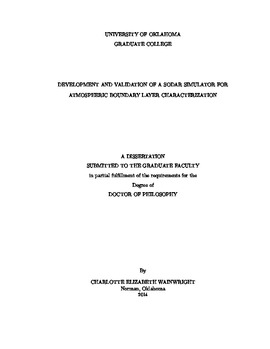| dc.contributor.advisor | Chilson, Phillip | |
| dc.contributor.advisor | Palmer, Robert | |
| dc.contributor.author | Wainwright, Charlotte Elizabeth | |
| dc.date.accessioned | 2014-05-15T16:21:35Z | |
| dc.date.available | 2014-05-15T16:21:35Z | |
| dc.date.issued | 2014-05-09 | |
| dc.identifier.uri | https://hdl.handle.net/11244/10427 | |
| dc.description.abstract | A sodar simulator capable of producing time-series data emulating sodar signals
has been developed and tested. The atmospheric elds used to populate the sodar
simulator are taken from output of a large eddy simulation code. The characteristics
of the sodar (number of beams, azimuth and zenith angles of the beams, beamwidth,
transmit frequency, range resolution, etc.) are de ned by the user to allow evaluation
of and comparison with existing systems. The range of the re
ected acoustic signal
is calculated based on a temperature-dependent speed of sound. Realistic acoustic
background noise is simulated using ltered white noise. The raw acoustic time-series
data are processed using a Fourier transform to yield acoustic Doppler spectra, from
which the radial velocities are calculated. The design of the simulator allows for the
testing of and comparison between various signal-processing techniques and averaging
periods.
Several di erent methods for validating the results of the time-series sodar simulator
are presented, including validation of the derived wind speeds against a simulated
instrumented tower and a moment sodar simulator, which evaluates the wind components
using the radial velocities measured by the sodar beams, and as such includes
the e ects of the DBS technique. The results of the sodar simulator are also used
to evaluate vertical pro les of the structure function parameter for temperature, and
these pro les are compared against those derived from a simulated unmanned aerial
system, and evaluated from the large eddy simulation output directly.
Two example cases are presented of populating the sodar simulator with large eddy
simulation data representative of one developing and one fully developed convective
boundary layer, and a third example case using large-eddy simulation output of a
stable boundary layer. | en_US |
| dc.language | en_US | en_US |
| dc.subject | Environmental Sciences. | en_US |
| dc.title | Development and validation of a sodar simulator for atmospheric boundary layer characterization | en_US |
| dc.contributor.committeeMember | Klein, Petra | |
| dc.contributor.committeeMember | Fedorovich, Evgeni | |
| dc.contributor.committeeMember | Kelly, Jeffrey | |
| dc.date.manuscript | 2014-05-09 | |
| dc.thesis.degree | Ph.D. | en_US |
| ou.group | College of Atmospheric & Geographic Sciences::School of Meteorology | |
